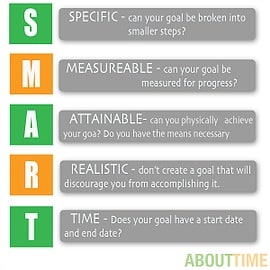Goal setting may be the most important part of your entire program. While it may seem simple to pick a goal and work towards it, often a poorly selected goal can lead to feelings of failure and ultimately lead to falling off of your program. Alternatively, if you consistently pick goals that are easy to achieve you may become bored, and lose interest.
The first step to setting a goal is recognizing that you should set short term and intermediate goals with the expectation of not reaching them entirely. This may sound strange, but you have to be okay with not getting to 100% of goal accomplishment. Setting realistic and almost reachable goals in small increments will ensure that you are consistently working towards your larger overall goal. If you plan on losing 8 pounds in one month, you should be okay with anything between 4-6 pounds, that’s great progress! Keep your goal at 8 pounds for the next month. If you fall drastically short and hit 2 pounds, it is equally important to adjust your goals to perhaps 4 pounds to avoid the feeling of defeat. You can also set a range as in “Lose 4-8 pounds in 4 weeks.”
Now that we have discussed mindset, let’s discuss the different types of goals. The most common goals are: weight-loss, cardiovascular fitness, increase strength/power, increase size, win a competition, or gain functional abilities. Setting a specific goal is vital to your success. If you simply choose “get healthier” you have no way of measuring your goal and therefore have no way of motivating yourself. Think about it like a business. If a business just set a goal of “doing well” and never tracked profit, how would they know if they were succeeding or failing?
http://cdn.tryabouttime.com
When selecting a goal use the acronym S.M.A.R.T. This stands for Specific, Measureable, Attainable, Realistic, and Time-bound. Let’s use some examples.
Weight-Loss: “I will lose 4-8 pounds over a 4-week period.”
This goal is specific to weight-loss measured in pounds. It is measurable by a scale. It is attainable considering that it is recommended to lose weight at a 1-2 pound rate per week. It is realistic. It is time-bound, 4-weeks.
Increase in strength: I will increase my back-squat 6 repetition weight by 20-pounds within a 4-week period.
This goal is specific to strength gain (measured as ability to generate force output for 4-6 repetitions. It is measurable in pounds. It is attainable depending on how much you are already squatting (it is recommended to increase large muscle group weight at a rate of 5% per week). It is realistic, and it is time-bound.
Cardiovascular fitness: “I will decrease my resting heart rate (RHR) by 5 beats per minute in a 4-week period.”
To avoid redundancy I won’t go into SMART principles here, but instead explain that a lower resting heart rate means that the system that carries oxygen from your lungs to the blood, to the heart, then out to your muscles is more effective. Normal (RHR) is between 60-100bpm.
There you have it, the most important piece of the puzzle. This is the most vital tool to build confidence, self-assuredness, and a feeling of accomplishment to your exercise program. Write your goals down and put them somewhere you can see them every day. You may have noticed that the goals are written as an affirmative, I will. Prime your mind to succeed an avoid less assertive wordings such as “I would like to” or “I want to.”
In the next blog we will discuss how to manipulate the variables in your program to continue achieving results and avoid those plateaus.







